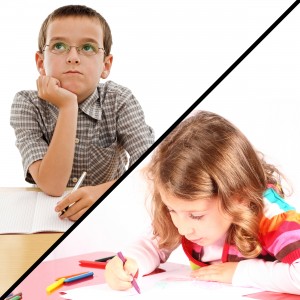There Was Me…

I first realized I was different in elementary school.
I liked to sit quietly at my desk, lean back, and think. I would be making connections in my imagination while my eyes were in the clouds, as if scanning for ideas. When I had an idea I really liked, I was tentative about sharing it, thinking that I might be giving away the good stuff, or exposing my tender baby to undue criticism. But I was confident my ideas would change the world.
And Then There Was Julie
My friend (let’s call her Julie) like me, was creative, but her approach was nothing like mine. She liked spilling her crayons all over her desk, as if to generate inspiring patterns. If I was quietly working away, she was constantly talking—talking about the work…talking to the work…talking through the work. I’m pretty sure she never had an idea that she didn’t tell someone else about, even if it wasn’t any good yet. And her desk was always messier than mine. She took creative risks, right out there in front of everyone. I admired that, but there was no way I was going to be like her.
Creating Differently
When I got older I was told that some people are creative types, and other people just aren’t. It’s not true. Everyone is creative. We just express ourselves differently and create differently, based on our personalities and preferences.
Cultivating Creativity
Creativity is a skill. Like any skill, it can be learned. Some people are more skilled than others at the creative pursuits. The way you master your skill expresses who you are. And who you are is unique.
Creative Profiles
Part of maximizing your creative potential is understanding your uniqueness. One helpful tool to discover your personality is the Myers-Briggs Type Indicator, based on the work of Psychiatrist Carl Jung. It’s the most widely used personality assessment in the world.
This indicates basic preferences for:
- How you gain and focus energy: Introvert (I) or Extrovert (E)
- How you gather information: Sensing (S) or Intuition (N)
- How you make decisions: Thinking (T) or Feeling (F)
- How you interact with the world: Judging (J) or Perceiving (P)
When you put them all together, you get a 4-letter personality signature. For example, since I tend toward Introvert, Intuition, Thinking, and Judging, my signature is INTJ. Julie, however, was probably an ESTP.
| The Sixteen (Four-Letter) Creative Types | |||
| ISTJ (The Organizer) |
ISFJ (The Facilitator) |
INFJ (The Inspirer) |
INTJ (The Visionary) |
| ISTP (The Crafter) |
ISFP (The Dreamer) |
INFP (The Muser) |
INTP (The Idea Mill) |
| ESTP (The Adventurer) |
ESFP (The Entertainer) |
ENFP (The Socializer) |
ENTP (The Brainstormer) |
| ESTJ (The Realist) |
ESFJ (The Teacher) |
ENFJ (The Persuader) |
ENTJ (The Commander) |
In his book Creative You, David B. Goldstein writes about the 16 different personality types and how creativity is expressed differently for each. He even goes so far as to indicate the personality types of famous artists, leaders, and inventors. It’s fun to connect their personality types to their work. For example, Edward Hooper (ISTJ, a thinker) painted deserted landscapes and lonely, ridged figures, whereas Norman Rockwell (ISFJ, a feeler) made his reputation on nostalgic small-town Americana.
Why it Matters
Understanding more about how you are wired can help you embrace your strengths and use them to your advantage. You can even tailor your environment, your creative process, and the projects you accept to match your natural bent. Playing to your strengths means less frustration and more productivity.
Change Over Time
If you took a personality inventory many years ago, it might be fun to take it again and see if anything has changed. I noticed this year that I scored more extroverted than I used to, which may mean that I’ve been adjusting to what works in my role as consultant, coach, and leader. I wonder if it means that my personality (which is supposed to be stable over time) is changing, or if I’m simply adapting to the new demands in my environment.
Curious?
If you are curious about your personality type, and what do do about it, here are some suggestions.
- Quick online assessment
This is not the most thorough, but it’s a good starting point. - Hire a coach certified in MBTI to do a complete assessment and develop a plan for meeting your creative objectives with your personality in mind. (e.g., Mike Boyes)
- Read Creative You: Using Your Personality to Thrive by David B. Goldstein & Otto Kroeger
- Go beyond personality and get insight into your natural abilities using the Highlands Ability Battery.